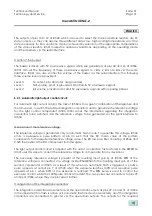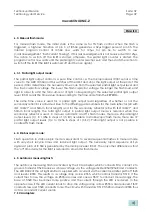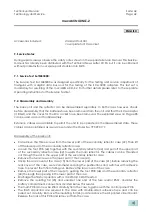
Technik und Service
Seite: 38
Technology and Service
Page: 38
mecablitz 40 MZ-2
ENGLISH
capacitors switch to the high-impedance state only when a flash is triggered in automatic flash
mode. The additionally required capacitors (depending on the aperture setting) are connected in
parallel to the existing circuit branch C533, C526 and R570. The integration capacitors are charged
from the 24V supply via resistor R531 and photodiode D001. When the reference voltage is
reached, IC503 generates a positive pulse. After the flash, the integration capacitors are
discharged via R556 and the open-drain output at pin 27 of IC504.
Compensation in the close-up range:
Due to the switching times of the various components, undesirable overexposure may occur in the
close-up range. In order to compensate for this unwanted light, the resistors R570, R571, R572 and
R573 are connected in series with the individual integration capacitors. The voltage drops across
these resistors have the greatest effect when the currents are high, i.e. with large amounts of
reflected light such as occur in the close-up range: This additional voltage drop thus causes the
light output to be interrupted earlier.
6. Special flash functions:
6.1. TTL flash control:
When TTL flash control is used, the initial state is as follows: the flash capacitors (C001 and C002) are
fully charged, the IGBT Tr401 is conducting (pin 36 of IC404 is low), and a partial light output may
have been selected and the related time value transferred to IC504. A high-low transition at pin 3
of IC504 generates a 32µs trigger pulse at pin 35. The internal program control of IC504 now waits
for 125µs for pin 34 to switch to low (=acknowledgement "flash current flowing"). If this
acknowledgement is not received within 125µs, the action to switch off the IGBT is started;
otherwise, the partial light counter is started. The program control now waits until either the partial
light counter reaches zero or a TTL "flash off" pulse appears at SCA contact 7, and then starts the
action to switch off the IGBT. If the TTL pulse arrives before the counter reaches zero, the exposure
control signal is set. In order to switch off the IGBT, IC504 emits a high signal at pin 36; after a preset
delay, the IGBT is then switched on again.
6.2. Cordless TTL flash control (Controller):
For cordless TTL flash control, the controller flashgun emits a light pattern defined by IC301. The
control signal for this is connected to the Syn input at pin 3 of IC504. The light output is controlled,
just as for a normal TTL flash, via the TTL "flash off" pulse at SCA contact 7.






































